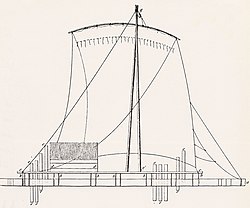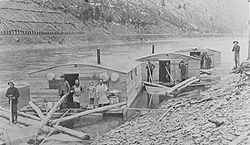- Three Arks for a log drive on Pine Creek, in Lycoming or Tioga County, Pennsylvania. The left ark was for cooking and dining, the middle ark was the sleeping quarters and the right ark was for the horses. The arks were built for just one log drive and then sold for their lumber. The line of the Jersey Shore, Pine Creek and Buffalo Railway can be seen on the eastern shore: the mountainside behind it is nearly bare of trees from clearcutting. [6]
- Raft carrying visitors to Tom Sawyer Island at Disneyland, about 1960
- People on the raft in Estonia, 1944
- Raft used to ferry vehicles at Citarum River, Karawang, West Java, Indonesia
- Rafting on the Dunajec River at Pieniny, about 2005–2010
- A woman using a raft to transport her daughter and goats

A raft is any flat structure for support or transportation over water. [1] It is usually of basic design, characterized by the absence of a hull. Rafts are usually kept afloat by using any combination of buoyant materials such as wood, sealed barrels, or inflated air chambers (such as pontoons), and are typically not propelled by an engine. Rafts are an ancient mode of transport; naturally occurring rafts such as entwined vegetation and pieces of wood have been used to traverse water since the dawn of humanity.








